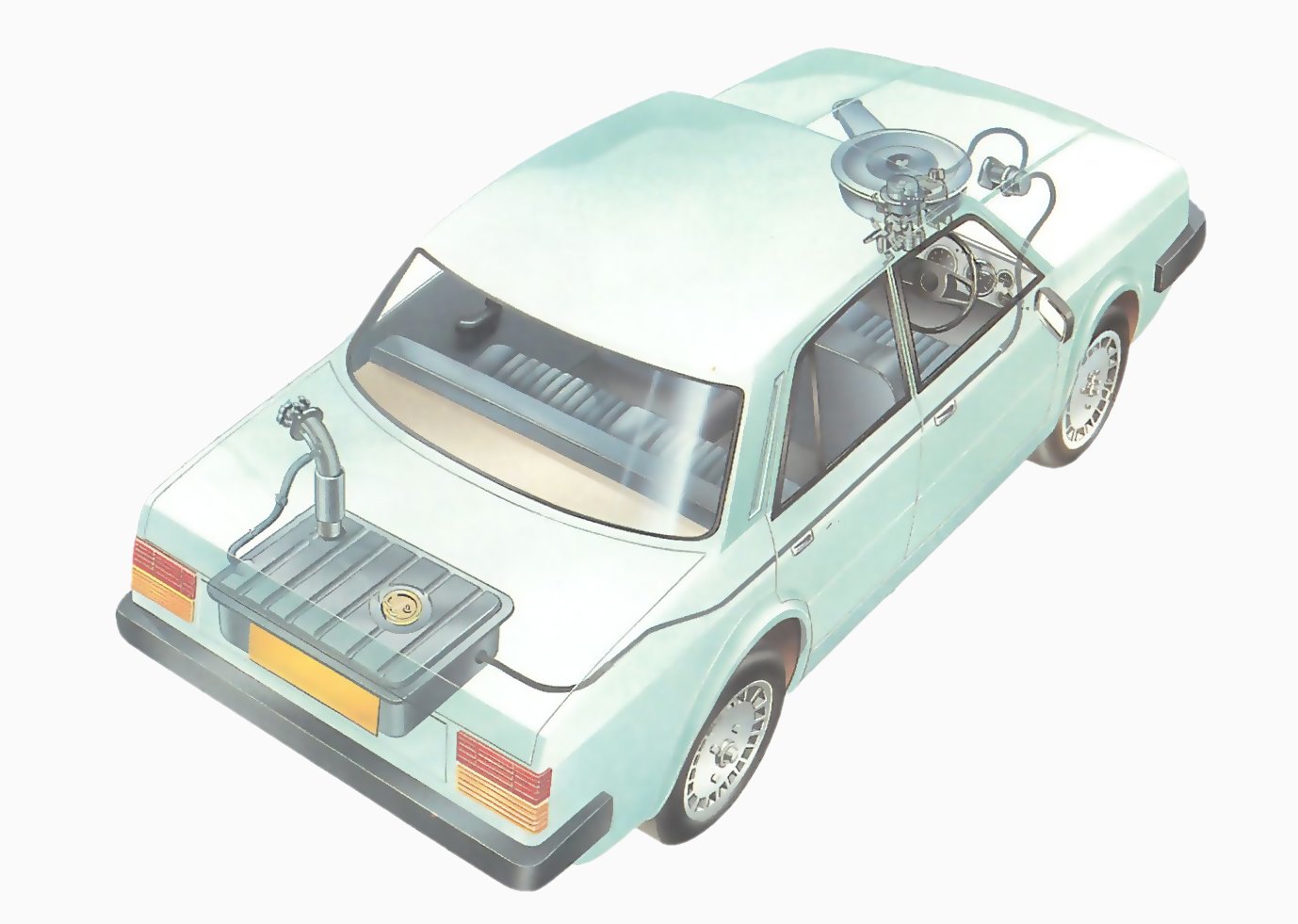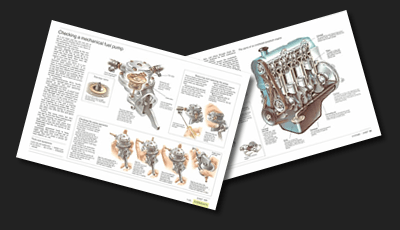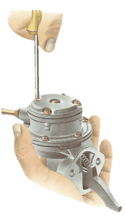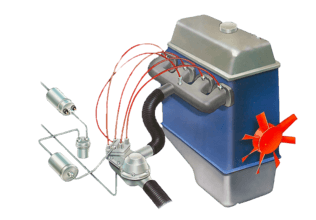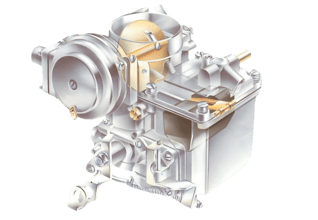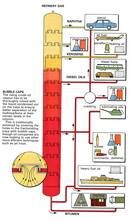
Vous pourriez avoir besoin de
A typical fuel system
A single fuel pipe runs from the tank, under the floor of the car to a mechanical pump on the engine. The pump delivers fuel to the carburettor.
The fuel supply system is generally reliable and any problems that do occur are usually traceable to the pump, the fuel filter or the tank. Occasionally, however, the fault lies in the fuel line between the tank and the engine.
Pipes can suffer from two main faults: leaking or blockage. Probably the first indication you will get of a leak is the smell of petrol wafting into the car - don't delay in finding the problem, as the petrol vapour can be ignited easily.
Twin fuel-pipe system
Twin fuel pipes are checked for leaks in the same way as single ones.
This video course is the best way to learn everything about cars.
Three hours of instruction available right now, and many more hours in production.
- 4K HD with full subtitles
- Complete disassembly of a sports car
Blocked pipes are usually very obvious - the car comes to a halt or suffers from fuel starvation. Thankfully this is now rare because fuel filters are fitted to remove dirt.
Types of pipe
The fuel line typically consists of rigid metal pipes, with flexible rubber or plastic hoses running from the pipes to the tank and the fuel pump, and from the pump to the carburettor. The flexibility of the hoses allows some movement between these different components. On some cars the rigid pipes are made of reinforced plastic rather than metal.
Inspection
A fault in the pipes and hoses, or in their connections, is a potential fire hazard, so you should check the system every year.
Disconnect the battery as a safety precaution against any possible sparks. Jack up the car and support it on axle stands. Carefully inspect the pipe along its whole length. Look especially carefully at the joints, checking for dark stains that indicate a leak. Use a spanner to check that all union pipe connections are tight.
Also check each metal pipe for rust - use a wire brush to remove any surface rust on the pipes. If the pipe is badly pitted underneath it should be replaced.
Inspect the flexible hose and connections too. Bend and twist them, looking for any splits. If the pipe has become hardened due to old age or is soft because of oil contamination, it should be replaced. Flexible pipes use several types of securing clip; make sure they are tight and not corroded.
Check the routing of the pipes, they should not run too close to hot engine parts such as the exhaust pipe or manifold. Check the pipe is secure in its clips and isn't chafing on anything.
If you found a pipe or hose that is badly damaged it will need replacing. Before you start work, drain the fuel from the tank into a suitable container and store it safely.
Replacing a flexible fuel pipe
Undo the clip that holds one end of the pipe. There may be a Jubilee-type clip (as here) or a wire clip. If a wire clip is used, always replace it with a Jubilee clip.
Pull the pipe off the stub (here on a carburettor). If it is stuck, ree it by gently twisting from side to side. Don't try to tug it off —you may dislodge the stub.
Move to the other end of the pipe and release the clip holding it. Here it is attached to a plastic in-line disposable fuel filter. Again gently pull the pipe free.
The filter has plastic stubs so when fitting the flexible pipe be very careful not to do up the clip too hard. If you overtighten, the stub will be crushed.
Replacing a rigid fuel pipe
Disconnect the pipe from the fuel tank.
Prise the clip down to remove the pipe.
Pull the pipe away. Be careful - it may still contain petrol.
Release the joints at both ends of the rigid pipe. Remove or bend back the securing clips from the pipe to release the pipe from the floor.
Withdraw the pipe from the car. Remember that the pipes are often quite long and a fair amount of fuel may still be inside them.
New hoses
The ends of the flexible hoses are usually secured with small Jubilee-type clips. Loosen these with a screwdriver and slide them along the hose. If the hoses are fitted with spring clips, grip them with pliers to expand and remove them. Replace all spring clips with new Jubilee ones.
Twist and pull the hose to release it. If the hose refuses to budge, pour some hot water over it to make it expand. Never use a naked flame to heat the hose. If the hose still won't move, a last resort is to cut it away with a pair of side cutters (large-nosed pliers with a cutting edge) or a hacksaw.
When buying the new hose, make sure it has the same inner diameter as the old one. Slide the hose into place so that it overlaps the pipe or stub by about lin (25mm). Place the clips a little way in from the ends of the new hose and tighten them up. Don't over-tighten them.
New pipes
To renew a rigid pipe first drain the fuel tank or, if draining is difficult, disconnect the fuel pipe from the tank and quickly plug the open end.
Starting at the back of the car, undo the union nuts or clips securing the pipe to the fuel tank and the car floor or chassis. The clips unscrew, bend back or pop out. Disconnect the pipe at the front, then remove from the car.
New sections are usually supplied by the dealer ready-made to the correct shape. If the pipe connections are union joints these should be renewed at the same time. Fit the new pipe loosely in place. Tighten the connections at each end and do up the securing clips, again making sure that the new pipe cannot rub on other components and is positioned away from hot engine and exhaust parts.
Pipe repairs
You can repair a small section of metal pipe by cutting out the damaged section and fitting a small piece of flexible hose in its place. First, carefully cut out the section with a hacksaw. Make sure you clean the pipe ends of any swarf caused by the cutting. Use a piece of flexible hose of the correct inside diameter to fit around the pipe and secure it with clips.
This repair should only be carried out if the length of damaged pipe is less than 6in (15cm), otherwise there is a danger that the flexible hose will sag and become vulnerable to damage.
Emergency repairs
If you discover a leaking pipe on a journey, you can carry out some emergency repairs just to get you home or to a garage.
If a hose is leaking you can cut it at the leak and insert a piece of rigid piping into it. Secure the pipe by tying thin wire such as garden wire around it.
A similar repair can be carried out on a pipe, this time positioning a length of hose over the pipe and securing in the same way as above.
You can also reduce a fuel leak by first drying the area as thoroughly as you can, and then quickly wrapping some polythene around it, secured with insulating tape and wire.
Filters
Many fuel pipe problems are caused by the filters becoming blocked. There are different types of filter of which one of the most common is the plastic in-line type. Check along the fuel pipes until you see the filter, which is usually barrel shaped. It is often transparent and you can see if it is blocked.
Servicing an in-line fuel filter
An inline fuel filter
The disposable in-line fuel filter is usually fitted under the bonnet in the fuel pipes between the fuel pump and carburettor. Some models are transparent so that you can see when they have become blocked. If in any doubt about the condition of the filter, change it. New ones are cheap to buy.
First release the fixings holding th filter to the fuel pipes. Some designs use Jubilee clips while others have union nuts. Remove the filter then fit the new one in place. Make sure the arrow is pointing in the direction of fuel flow.
Plastic in-line fuel filters are usually secured at each end by a Jubilee clip. Undo them with a screwdriver.
The in-line filter may have a metal body and be secured by a union nut at each end. Undo these with a spanner.
Servicing a glass-bowl filter
Use your hand to undo the nut.
The other type of fuel filter you may find is usually in the engine bay, and consists of a filter element mounted inside a glass bowl. The bowl hangs down from a metal mounting that is secured in the inner wing by bolts or screws. Before you start, find out from your dealer if the filter element is disposable or if it can be cleaned. If it is disposable, get a new one.
Place a container under the filter bowl to catch petrol, then undo the knurled nut under the glass bowl. Lower the bowl off and pour out the petrol. If it is stuck, gently jar it free with your palm. Remove the filter element and either discard it or clean it with petrol and a soft paint brush. Clean out the filter bowl and replace the filter— make sure the knurled nut is tight.

